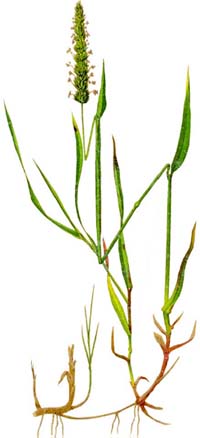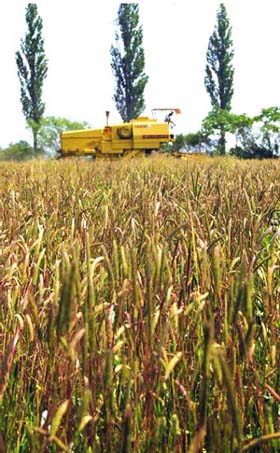
Phleum hirsutum (Schröter, 1888)
BOTANY
Perennial, thin to dense cespitous grass with short rhizomes and numerous young shoots breaking though the base of the leaf sheath.
Culms are 20-60 cm high, slender, not branched, erect or geniculate, smooth and glabrous, two to four-noded, apical culm internode is approximately half to two-thirds of the length of the entire culm. Nodes grooved and glabrous.
Leaf sheaths clustered on base of culms, dense above nodes, 1 mm long, hair pointing downwards, in the end breaking up into irregular pieces, those at culms grooved and glabrous.
Ligule is a 1-3.5 mm long, membranous fringe that is acuminate or truncate at the upper end and shortly and finely ciliate on the outside.
Leaf blades 8-25 cm long, 2-6 mm wide, flat, both sides heavily grooved and scabrous, white margins with dense, spiky hair.
Inflorescence a panicle, 2-10 cm long, 8-12 mm wide, light green, often coated purple, cylindrical, both ends edgeless, loose when bent, often slightly interrupted; lateral branches as well as main axis shortly and densely pilose.
One-flowered spikelet, appendix of axis is about 1 mm long above floret, including awns 4.5-6 mm long.
SUITABILITY FOR RESTORATION
Phleum hirsutum is a central and south European montane plant. In the Alps it grows in the upper montane and subalpine zones, but seldom in lower alpine zones. The rhizomes enable this plant to disperse on stony soils with shallow layers. It prefers arid, wellaerated, exposed sites with light, alpine brown soil that is occasionally heated, rich in bases and moderately rich in nitrogen, having a limy bedrock and pararendzina with stones at very low to intermediate depth and with a pH between 5.9 and 6.8. In the central Alps the plant grows up to 2 400 m above sea level.
Important species for restoration of arid, sunny sites with limy bedrock.
High tolerance of nutrients, quite high tolerance of cutting, good and fruitful forage.
SEEDS
Fruit of the husk 2-3 mm long, 0.5-0.9 mm wide and thick, ovate-lanceolate.

Seeds
Lemma keeled, veined, glabrous, acuminate.
Palea rather small, flimsy; only a narrow part can be seen through lemma.
Surface tawny-brown, shiny.
Fruit 1.5-2 mm long, 0.6 mm wide and thick, yellow (to brown), matt.
Thousand seed weight: 0.25-0.4 g.
REQUIREMENTS
(soil and climate)
This species prefers a light, well aerated soil that is not too acid, and a pH of 5.9-7.5.
Because of the plant’s slow juvenile development and low competition with weeds, it requires soils with low weed infestation, especially regarding meadow grass, quack grass, loose silky bent and crab grass.
CULTIVATION
This species requires a thoroughly prepared seedbed.
Open sowing is possible until the end of June, if irrigation is available.
Positive experience has been gained with summer barley or linseed as a cover crop. A thin cover crop population is important. Seeds have an excellent seed flow and seedings are therefore unproblematic.
Seed rate: 8-10 kg/ha.
Row spacing: 15-20 cm. Broadcast seeding is possible.
FERTILIZATION
Phosphorus and potassium: on soils with an intermediate supply of phosphorus and potassium, fertilization with solid or liquid manure is sufficient. For soils with good nutritional content, amounts of 40-60 kg/ha P2O5 and 80-100 kg/ha K2O, depending on crop yields, are sufficient.
Nitrogen: after harvesting the cover crop and cutting the stubbles, an application of 30 kg/ha N-total is recommended, in order to achieve optimal development until autumn. The amount of nitrogen necessary for seed development is 70 kg/ha N-total, which should be applied in autumn and early spring. Late fertilization in spring mainly stimulates the development of leaves.
MAINTENANCE AND WEED CONTROL
This species is generally tolerant of herbicides. For application of hormonetype and broad-spectrum herbicides see Table 3. The use of herbicides is necessary even for low weed infestation. Early application is important because high weed competition has a disproportionately high impact on crop yields.
A specific problem is weed infestation by Poa annua (annual meadow grass), which may lead to intense competition with young plants and subsequent contamination of seeds. Selective weed control with Ethofumesate is possible when weed infestation is low. However, it is not possible to give general instructions. An expert survey is necessary in order to recommend a specific composition.
In summer and autumn after the first harvest, severe infestation of rust may occur. Constant inspection and the application of fungicides are necessary. Insufficient control can lead to a breakdown of the populations over wide areas. In any case the application of customary broad-spectrum fungicides for cereal cultivation is necessary to avoid substantial decreases in crop yields the following year. Cutting in late summer is helpful but it should not substitute the application of fungicides because this could lead to high weed infestation.
Phleum hirsutum has low biomass production. Therefore its use as forage is not economical. However, cutting is necessary in autumn of the first growing year.

Seed harvest in eastern Austria
HARVEST AND YIELDS
Resistance to lodging: high.
Shattering tendency: low to intermediate.
Ripeness: spikes change colour to brown, culms to yellow. It is time for threshing when brown and rather hard seeds shatter when the spikes are rubbed. Seed producers often tend to thresh this species too early.
Ripening period: middle to end of July, seven to ten days after cat tail grass.
Harvesting techniques: threshing is done from the root and is unproblematic.
Crop yields: for well-maintained populations the crop yield in the second harvest year is usually higher. Crop yields are between 100 and 150 kg/ha in the first and 100-200 kg/ha in the second harvest year. Propagations with intensive weed control have produced yields of up to 500 kg/ha.